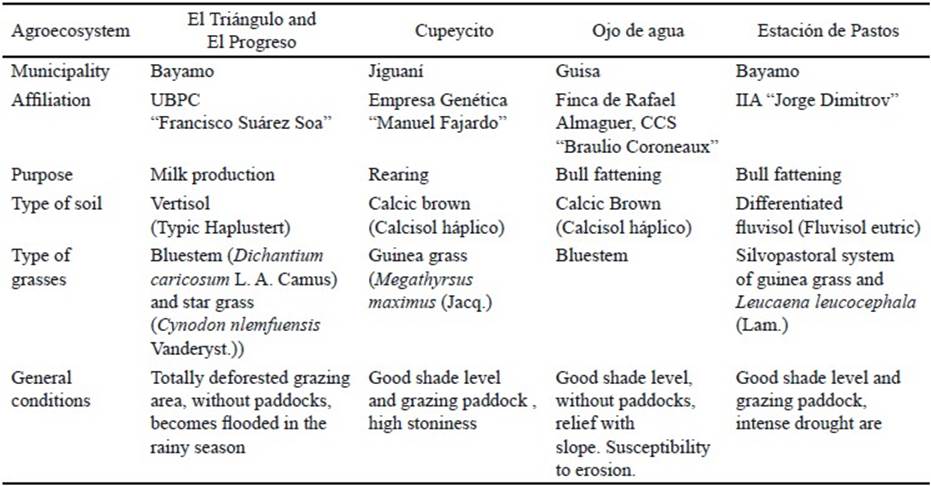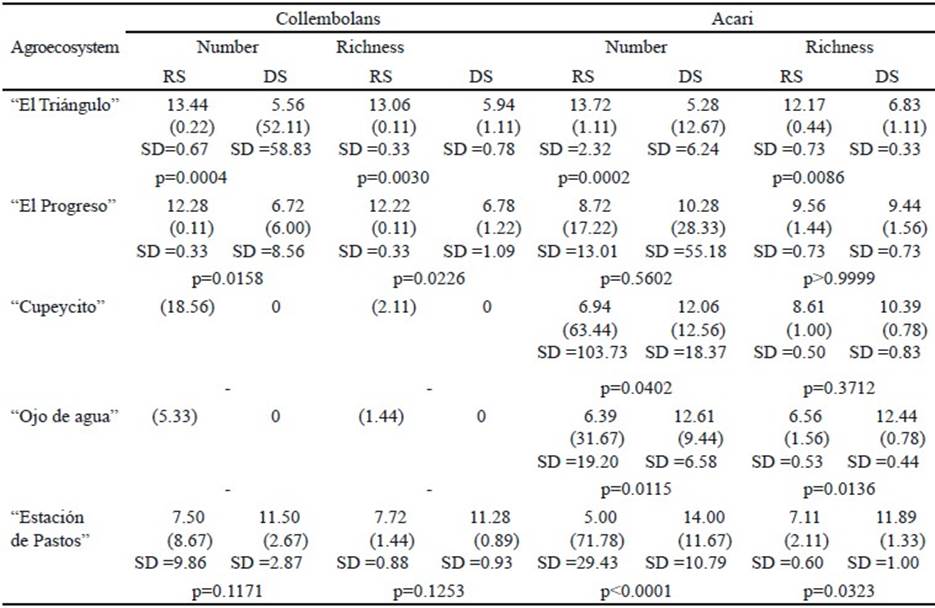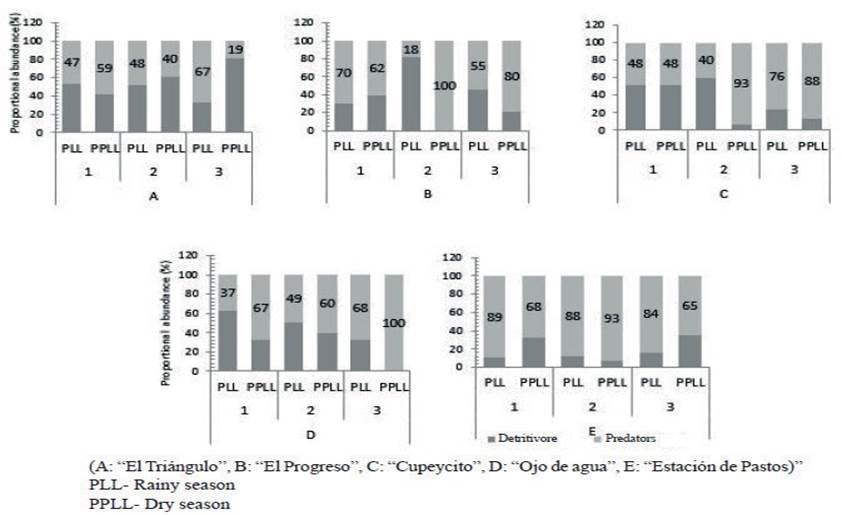INTRODUCTION
There is currently a great interest in the scientific community on the selection and evaluation of soil quality bioindicators, due to concerns about the increasing degradation of the soil and the need for sustainable management of this resource (Lok 2016). In this sense Guidetti et al. (2017) suggested the use of the edaphic mesofauna as a bioindicator, for being sensitive to the type of soil management and changes in climate and vegetation. In addition to, it also recognizes its essential role in the decomposition of organic matter, the recycling of nutrients and its participation in the different trophic networks in the soil (Socarrás 2018).
According to Águila et al. (2016) in Cuba there are few researches that focus on the study of mesofauna and its relation with agricultural use and management. In this sense, the main studies carried out in grasslands have been developed in the western region of the country (Rodríguez et al. 2011, Socarrás and Izquierdo 2016 and Socarrás 2018). However, there are no references to this type of study in the eastern region of Cuba. That is why the objective of this research was to characterize the edaphic mesofauna in five grassland agroecosystems of Granma province, Cuba.
MATERIALS AND METHODS
Location. The research was conducted from July 2014 to March 2017, in different locations from Granma province, located in the southwest portion of the eastern region of Cuba, at coordinates 20°23'00"N76°39'09"O. Five grassland agroecosystems with contrasting characteristics were selected for the study (table 1). Soil classification was carried out according to Hernández et al. (2015) and the Soil Taxonomy (2003).
Table 1 Characterization of the studied agroecosystems

UBPC: Unidad básica de producción cooperativa; UEB: Unidad estatal básica y CCS: Cooperativas de créditos y servicios.
Climatic conditions. In general it is characterized by having a warm tropical climate like the rest of the country. Some peculiarities of the local climate are associated with its high temperature, the annual average is from the order of 25 to 27 °C, very accentuated during the summer and especially in July with 27 to 28 °C. In general, both the annual and monthly average accumulation of precipitation, performed superior than the historical accumulations of the last five years, except in the months of June and July where the accumulated were lower.
Experimental procedure. In each agroecosystem the representative sampling areas were selected, according to the total area dedicated to grazing. In "El Triángulo" and "El Progreso" a paddock of two hectares was selected in each one, in "Cupeycito" of 1.8 ha, in "Ojo de agua" of 1.2 ha and in “Estación de Pastos” 0.8 ha. The sampling was carried out once in the rainy season (RS) (July to September) and once in the dry season (DS) (January-March). For the characterization of the variables under study and the statistical analysis, three years were defined: year1 (RS-2014 and DS-2015), year 2 (RS-2015 and DS-2016) and year 3 (RS-2016 and DS- 2017).
Nine pitfall traps (Greenslade 1964) were placed in the study area, arranged in the diagonals, in a cross, with a trap in the center of it. Plastic containers of 10 cm in diameter and 8 cm deep were used, these were buried at soil level, with the least possible disturbance in the surrounding area. Once buried, a 0.003 % aqueous detergent solution was added, prepared with commercial liquid detergent from LABIOFAM, and covered with dry leaves and plant wastes from each grassland. After 7 days, the content of the traps were collected in glass bottles and immediately transferred to the laboratory. The individuals were extracted and counted and placed in vials with 70 % ethanol, for later identification. The classification was carried out according to the studies of Brusca and Brusca (2003) and Díaz et al. (2004), among others. The variables studied were: number and richness of collembolans and acari.
The ecological indexes of Shannon-Wiener (H'), dominance of Simpson (λ) and Berger-Parker (d) (Moreno 2001) were calculated. The proportional abundance of trophic groups was also calculated, taking into account the number of individuals that belonged to each group, with respect to the total.
Statistical analysis. The non-parametric variance analysis was performed by the Wilcoxon (Mann- Whitney U) (Lehmann 1975) method for independent samples based on the ranges of the original observations, where the variables between the RS and DS of each year previously defined were compared. The Conover (1999) test was applied for the comparison of average ranges.
Previously, the theoretical assumptions of the analysis of variance for the studied variables were verified, from the Shapiro and Wilk (1965) tests for the normality of errors and Levene (1960), for the variance homogeneity. As the variables analyzed did not fulfill with the theoretical assumptions of the ANAVA, the √x transformation was used. However, as this one did not improve the fulfillment with these assumptions, the non-parametric variance analysis was performed. The statistical package INFOSTAT version 2012, prepared by Di Rienzo et al. (2012) was used.
RESULTS AND DISCUSSION
In this study, individuals of the edaphic mesofauna belonging to two classes, four orders, six families, seven genera and five species were found(table 2). The Collembola order was the best represented with five genera.
Table 2 Taxonomic and functional composition of the edaphic mesofauna in five grassland agroecosystems of Granma province

Studies carried out in Cuba on grassland agroecosystems (Rodríguez et al. 2011 and Socarrás 2018) show a diversity of mesofauna similar to that of this research, although these researches were conducted in the western region of the country under different edaphoclimatic conditions.
On the other hand, Socarrás and Izquierdo (2016) in a study carried out in a grassland on a typical red Ferralitic soil, located in Artemisa, composed of M. maximus, Cynodon nlemfuensis and Teramnus uncinatus, reported the presence of acari belonging to Oribatida and Gamasidae as the most abundant, which coincides with the findings in this study. Similar results were obtained by Águila et al. (2016) in other agricultural agroecosystems on soft brown soils in Villa Clara province. The oribatid acari have been pointed out as bioindicators in agricultural soils because they interact in the decomposition of organic matter in interaction with the microflora. In addition, they are sensitive to humidity, pH, agricultural practices performed by humans and the use of insecticides. The gamasines are recognized as predators and exercise control over nematode populations and other edaphic microarthropods (Socarrás 2018). These are related to disturbed soils that have unfavorable changes in the humidity regime.
The representation of Collembola order in these agroecosystems constitutes an indicator of their status. Collembolans have generally been used as bioindicators of soil quality and ecosystem management (Cuchta et al. 2019). The presence of the Entomobryidae and Isotomidae families in this study could be associated to the contribution made by animals with their excreta to the recycling of nutrients, since according to Socarrás and Rodríguez (2001) these families are associated with managed soils with agro-ecological alternatives from the use of different types of organic fertilizers.
Influence of the season on the richness and abundance of the edaphic mesofauna. It is recognized that the mesofauna is very sensitive to climate changes, which cause variations in its density and diversity (Socarrás and Izquierdo 2014). In this study, only significant influence of the season was detected on the richness and abundance of the edaphic mesofauna, in the third year in all the systems (table 3).
Table 3 Influence of the season in the edaphic mesofauna (collembolans and acari) in five grassland agroecosystems of Granma province during the third year including the RS-2016 and DS-2017

Average of the ranges, ( ) mean of the original data, SD: standard deviation of the original data
In the agroecosystem "El Triángulo" there were significant differences in all the variables under study, in this case they showed a better performance in the DS. In "El Progreso" there were significant differences in the variables corresponding to collembolans which were superior in the DS; in "Cupeycito" only for the number of acari and in the “Estación de Pastos” for the two variables corresponding to acari, who in all cases were better represented in the RS. In the agroecosystem "Ojo de agua" there were significant differences in the two acari variables that, in this case, showed a better performance in the RS.
The obtained results were lower than those reported by Hernández et al. (2018), who obtained higher values of the total mesofauna in the RS with respect to the DS, with predominance of this zoological group in the forage areas with regard to grasslands and polyculture, in Cangrejeras town, Artemisa, Cuba. However, in other researches Fernández et al. (2015) obtained a higher number of acari in the DS, in four farms in conversion to agroecological production on soft brown soil with and without carbonates, located in Cruces municipality, Cienfuegos province.
Regarding the performance of collembolans, it could be seen that in the agroecosystems "Cupeycito" and "Ojo de agua" only their presence was detected in the RS (table 3); which coincides with that reported by Cole et al. (2006) who found a maximum presence of these groups in the RS. However, in the agroecosystems "El Triángulo" and "El Progreso" the performance of this group was statistically superior in the DS, which could be due to local climatic variations, since these areas are nearby.
In most of the samplings in the agroecosystem of the “Estación de Pastos” a higher number of individuals of the mesofauna were determined, which could be associated to the presence of the silvopastoral system. In studies conducted in Nicaragua, Escobar et al. (2017) also reported a higher abundance of acari and collembolans in silvopastoral systems compared to other ecosystems of traditional paddocks and broadleaved forest.
Ecological indexes. According to Moreno (2001), the main advantage of the ecological indexes is that they summarize a lot of information in a single value and allow to make quick analyzes between the diversity of different habitats or the diversity of the same habitat over time and suggest that the most convenient is to have values of both the richness and some index of the structure of the community, in such a way that both parameters being complementary in the description of biodiversity, as was done in this research.
In this sense, the Shanon-Weiner index (H') showed low values of biological diversity (figure 1). The highest recorded value was 1.35 and was detected in the RS of the first sampling, in "Ojo de agua". In the rest of the agroecosystems and evaluated periods, the value was below 1.2. According to Ramírez (2013) the values of H' which are below the range of 1.5-3.5 show a low diversity; while Caicedo et al. (2018) stated that the biodiverse ecosystems can have values close to five. Wu and Wang (2018), meanwhile, in a study conducted in different types of forests showed H' values of the edaphic mesofauna close to three, which is indicative of better edaphoclimatic conditions for the development of this type of biota, with respect to grassland agroecosystems where this study was conducted.

Fig. 1 Ecological indexes of the edaphic mesofauna in five grassland agroecosystems of Granma province
The Simpson index (λ) and the Berguer-Parker index (d), performed variably in the agroecosystems, although it is necessary to highlight that in "El Progreso" and "Estación de Pastos", they were higher than 0.5, in most of the years.
On the other hand, there were no higher values of species richness (S) (table 4) or H', in the rainy seasons evaluated, compared to the dry seasons, with the exception of "El Progreso". In the agroecosystems "Cupeycito" and "Ojo de agua" the values of S and H' were lower in the last sampling period, which contrasts with what was observed in the grassland corresponding to the “Estación de Pastos”, whose values were increasing, even when the dominance indexes were high.
Table 4 Total richness of taxonomic units of the edaphic mesofauna in five grassland agroecosystems of Granma province

In this sense Guidetti et al. (2017) reported values of λ between 0.36 and 0.62, in a study of the edaphic mesofauna carried out in five land uses that included several types of grasslands in Paraná state, Brazil. These authors also found S values that ranged between 7 and 13 species.
Trophic composition of the components of the edaphic mesofauna. The soil mesofauna community was composed of two trophic categories in all the studied agoecosystems: detritivores and predators. These categories play an important role in the ecological stability of the soil. The predators were only represented by the Gamasidae (Mesostigmata) family, which is a predatory taxon of immature stages of oribatids and collembolans (Socarrás and Izquierdo 2016). The rest of the taxa identified in this study were classified as detritivores, except R. setosus, which due to its limited presence was not considered for the analysis.
Collembola is a detritivore order, an indicator of equilibrium and good edaphic conditions (humidity and OM quality), according to George et al. (2017). Cole et al. (2006), state that they play a decisive role in the recycling of organic wastes and are able to fraction and crush plant wastes, which increase the implantation of the microflora. The performance of the trophic groups by grassland was variable in each sampling carried out (figure 2).
It should mean the predominance of predators in all the samplings performed in the “Estación de Pastos”, which showed a proportional abundance of over 65 % in all cases. Apparently under the conditions of this silvopastoral system it was possible to maintain a balance in the prey-predator relation. This result could be indicative that the gamasines (predators) have good conditions for their development in this agroecosystem, which could be related to the availability of food and habitat conditions in general.

Fig. 2 Proportional abundance of functional groups of the edaphic mesofauna in five grassland agroecosystems of Granma province
However, Socarrás (2018) reported a higher number of detritivore organisms, followed by predators and fungivores in secondary forest, silvopastoral system and cultivated grassland, in Güines municipality, Mayabeque province. In previous studies, the same author showed that in both seasons and years of sampling, there was an increase in the number of detritivore individuals with respect to the rest of the trophic groups in the three studied areas: forage, polyculture and traditional grassland in Artemisa (Socarrás and Izquierdo, 2016).
In general, the results obtained in this study may be influenced by the variability of climate indicators (Herrera et al. 2018). These authors pointed out the variability of rainfalls and indicated to express them, moreover, as the number of days with rain, which will offer the possible distribution of the degree of soil humidity. All previous, join with the contrasting characteristics of the studied agroecosystems, may have had a direct influence on the variability of the performance of the observed edaphic mesofauna. Another factor to showed is the versatility in the temporal space distribution of this type of edaphic biota, which is dependent on the specific conditions of the microhabitat in the soil.
It is concluded that the richness and abundance of the edaphic mesofauna in the grassland agroecosystems studied was low and very variable in both climatic periods. There were individuals belonging to the trophic categories of predators and detritivores, which showed a variable relative abundance, in each agroecosystem and sampling performed; except in the “Estación de Pastos” where there was a predominance of predators. Finally, these results constitute a contribution to the researches on the edaphic mesofauna in grassland agroecosystems in the eastern region of Cuba, which should be deepened to achieve a better understanding of this group's performance of soil biota and its relation with edaphoclimatic conditions prevailing











 text in
text in 


